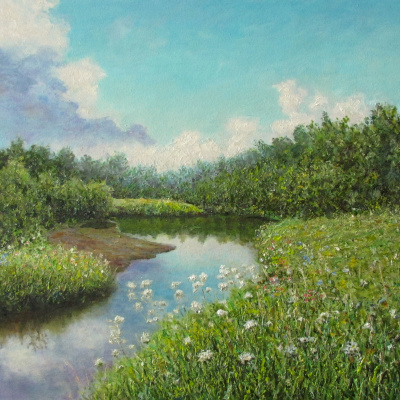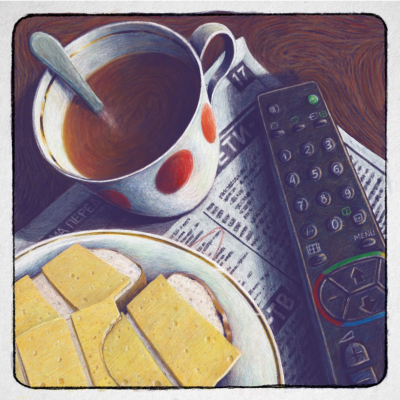Flaming June, arguably the best-known painting by Frederic Leighton, came back home to the UK to stay for several months from Puerto Rico where it "lives" nowadays. For the first time the canvas came to the place where it was painted, Leighton House Museum. Flaming June: the Making of an Icon exhibition shows also other paintings which Leighton submitted to the Royal Academy of Arts for the last time, just before his death in 1895.

At the exhibition in The Royal Academy of Arts critics were not unanimous when assessing the square canvas of a red-headed woman slumbering in an orange dress. In 1963 it was bought extraordinarily cheap by a governor of Puerto Rico.

Flaming June was one of six paintings created by Frederic Leighton, the Royal Academy’s president from 1878, prepared for the summer exhibition of 1895. He gave friends and guests, including the Prince and Princess of Wales, a preview of the set in his studio. A rare historical photograph of that display inspired the idea of the recent exhibition in Leighton House Museum.
Leighton’s studio on the eve of the exhibition in 1895. Photo: Bedford Lemere / Historic England Archive
The curator of the exhibition, Daniel Robbins assembled five of the six works from the artist’s original installation. Besides Flaming June (1895), we can see Lachrymal (Tears), 1895, from the Metropolitan Museum of Art in New York, Between Hope and Fear, The Maid with the Golden Hair, and Candida which have been in private collections since 19th century. Curators could not trace the sixth canvas, A Study, or Listener, the painting that Leighton sent to the Royal Academy instead of Candida.
Between hope and fear
1895, 110.5×84 cm
The exhibition Flaming June: The Making of an Icon also uncovers the process of creating Flaming June which is called now Mona Lisa of Southern Hemisphere. A cluster of exquisite sketches from collections of Leighton House Museum and the Royal Academy of Arts illustrates the way the artist methodically worked, day by day, year by year, on posture of a model and the whole composition.

Frederic Leighton, Lachrymal (Tears),
1894−1895, from the Metropolitan Museum of Art in New York.
First buyer of Flaming June was the owner of Graphic illustrated newspaper. He immediately realized the potential of the painting and made it popular by printing its free reproductions as a Christmas gift for his readers. Later on, in 1930, the canvas was displayed at the Leighton’s centennial exhibition. Its whereabouts after that were unknown up until it emerged again in 1962 when a certain builder brought it to a framing workshop. He claimed that he found it under some panel of a house he was demolishing.
Andrew Lloyd Webber, the famous composer and collector, regretted later that he hadn’t been able to buy the painting when he was a teenager for £50 only because his grandmother refused to lend him a shortage of £5.
Flaming June changed its owners several times; a number of British museums refused it, but in 1963 it was bought by Luis A. Ferré, the founder of a Puerto Rico museum (Museo de Arte de Ponce). The precious exhibit of the gallery in Puerto Rico, it leaves its current home rarely and only in extraordinary circumstances. Flaming June was on display at the Museo del Prado in Madrid in 2009 and stayed for the summertime in the Frick Collection in New York in 2015.
In exchange for displaying the Victorian masterpiece in its premices, Leighton House Museum promised to borrow the Museo de Arte de Ponce 20 paintings, sculptures and drawings from its collection in 2017.
Meanwhile, a celebrity came to welcome the artistic star at home. Jimmy Page — The Led Zeppelin composer and guitarist — visited the opening of the exhibition Flaming June: The Making of an Icon. Musician and avid art collector told that the painting of Leighton has inspired him in his early years.

Legend of the rock music Jimmy Page for the first time got a chance to see up close the painting, which fascinated him in his youth. Photo: A.Lentati.
"I connected with Pre-Raphaelite art in my early teens when I realised that there was a movement and a brotherhood. I was at art college for a period of time … but oil painting, things that I wanted to do, were avoided so I admired the techniques of the Pre-Raphaelites
from afar," - said 72-year-old composer.

To follow the example of Jimmy Page and admire the masterpiece of Frederick Leighton up close, visitors are welcome up to April 2nd, 2017.
Written by Vlad Maslow on materials by Leighton House Museum’s site, The Art Newspaper, and Evening Standard newspaper.













